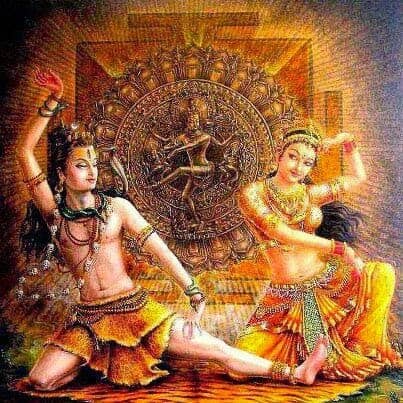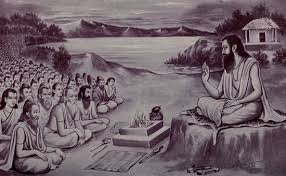Tandav and Lasya – Authentic Dance of the Universe
Tandav and Lasya
Tandav and lasya are the origin of dance and we will learn about the information related to Tandav and lasya like what is Tandav dance and what is Lasya dance?
Tandav (Dance of Lord Shiva)
According to the Indian tradition, Bhagwan Shankar has been considered the deity of dance. Shivji dances daily in his full of fun in the evening. All the people are involved in this joy and dance of Shiva. In this great joy dance, Brahma Ji gives rhythm, Vishnu Ji plays the mridang, Mata Saraswati Ji taunts her veena, Surya-moon flutes flute, Apsaras and eunuchs take care of the devotees, Nandi plays the drum and Bhrigi plays the Mandal Narada Ji mixes with them. The constellation of the earth moves with the movement of the earth and hands by the footsteps of Shiva. That is why it has been said, “The world is dancing”. This whole world is dance.

The postures were invented by Shiva in dance in this way and the tandumuni (nandishvara) of the postures were compiled one by one and began to practice them sitting in rhythm. When Bharatmuni with the permission of Brahmaji presented the drama named “Tripurdah” with his troupe to Shiva on the Mount of Kailash – then Lord Shankara suggested planning the dance in this drama experiment and ordered his beloved disciple TanduMuni Gave them to impart dance education to Bharata Muni.
Bharata-Muni teaches Tandav And Lasya
Thus the “Tandav” dance of Shiva became famous due to the teachings by Tandu. BharataMuni taught this dance to his sons. So this dance was propagated in Bhu-lok. Similarly, in the fourth chapter of his book Natyashastraam, Bharata Muni described the characteristic of the Tandav dance.
The dance in which every such dance, with the emotion of veer, vibhats, raudra, adhbhut, etc., which is worthy of men to perform, is called Tandav dance. Fast preparation has special significance in this dance. The movement of the post takes place at a very fast pace and according to that, the organs are also charged fully. Strong words like Dhadan, Tadhan, Thanga, Dhetta, Dhumkit, etc. are also used in their lyrics. In Kathak dance, the paran of the Pakhavaj is danced with this Tandava posture.
Types of Tandav Dance
According to this Lord Shiva conceived this dance form because he was very fond of dancing. Shiv’s Tandava is embellished with 108 Karanas and 32 embers. In ancient texts, the Tandava also finds mention of many distinctions. The seven distinctions of Tandava are explained.
1. Anand Tandava – Lord Shiva performs Tandava with bliss.
2. Tripura Tandava – Dance performed by Lord Shiva after killing Tripurasura signifies courage (valor) and extreme anger (raudra)
3. Sandhya Tandava- Tandava performed in the evening is in a sweet mood
4. Sanhar Tandava – The destruction of the entire universe is repeated in the massacre of Tandava
5. Kalika Tandava – To destroy evil, Shiva dances expressing his Bhairava form
6. Uma Tandava – This dance form represents conjugated affection, love, and attraction in its present and simple form.
7. Gauri Tandava – Shiva and Gauri danced together in Shringara Ras in this Tandava.
Lasya (Dance of Goddess Parvati)
Mata Parvati, inspired by the dance of Shiva, composed a dance that was composed of sugary tunas. It is said that after the demon Tripurasura was killed by Lord Shiva, he danced the Tandava in anger, then to appease and pacify him, Goddess Parvati Ji performed a soft and adorned dance called “Lasya” dance.
This dance expresses happiness and is filled with grace and beauty. He taught this dance to Usha, the daughter of Banasura. Usha was married to Anirudh, the grandson of Lord Krishna. Then on coming to Dwarka, Usha taught that dance to the women there. In this way, the lasya dance performed by Parvati Ji arrived on the earth.
In this dance, every such elegant dance which is capable of performing sukomal postures with emotions of shringar, Karun, etc. which is worthy for women to perform, is called Lasya Natya. In this, the organs are operated with great softness and beauty. The postures of the neck, eye, eyebrow, wrist, etc. are also operated on with great cleverness. in this dance the chalan is performed very beautifully and the expressions are displayed with softness. Its music is also melodious.
Three distinctions of Lasya
In Kathak dance, gata, thumri, and Kavita are danced with this lasya dance. Similarly, there are three distinctions of Lasya –
1. Vikat lasya – A dance form in which the rhythm, speed, the gesture is performed, which is known as Vikat lasya
2. Visham lasya – Chakkars, Bhramri, and special footwork is performed
3. Laghu Lasya – By generating sound on the earth through the anklet, the malformed design, laghu lasya is performed.
Thus we see that in Indian tradition, dance is divided into two parts tandav and lasya. In Tandava, the enthusiasm and vigor of man appear. In this dance, a mixture of versatility is performed with great beauty in the background of Seriousness. Whereas lasya is a Soft dance performed by women in the performance of soft expressions. Tandava and lasya forms can be seen differently in each dance form of India. today we will learn about the information related to Tandav and Lasya.
Tandav and lasya in Hindi / ताण्डव और लास्य (नृत्य की उत्पत्ति कथा)
ताण्डव
तण्डु मुनि
तांडव नृत्य के प्रकार
लस्या
लस्या के तीन भेद
2.विशम लास्य – चक्कर,भ्रमरी तथा विशेष फुटवर्क का प्रदर्शन किया जाता है
3.लगु लस्य – पायल के माध्यम से पृथ्वी पर ध्वनि उत्पन्न करके, कुंचित पदविन्यास, लगु लस्य का प्रदर्शन किया जाता है।







बहुत आवश्यक जानकारी आपने उपलब्ध कराई है ।एक बात सामान्यतः पाई जाती है कि तांडव नृत्य तो भोले बाबा का ही है बहुत जटिल और रपटिल है, फिर भी उन्मादी नर्तन करते हैं ।लास्य नृत्य को सोबर कहा जाता है ।कुछ लोक नृत्य में स्त्री पुरूष संयुक्त नृत्य करते हैं और विलग रहकर भी, किन्तु दोनो नृत्यों के मिश्रण पर ही समाहार होता है ।
शुभम् अति शुभम् ।
this is a very nice article and the best part is that the hindi version is also availabe…